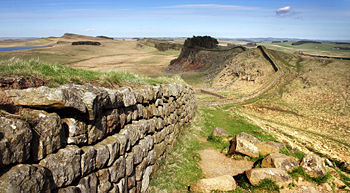Hadrian's Wall: Difference between revisions
Jump to navigation
Jump to search

imported>Stephen Ewen mNo edit summary |
imported>Joe Quick m (sp) |
||
| Line 1: | Line 1: | ||
{{subpages}} | {{subpages}} | ||
[[Image:Hadrians Wall.jpg|right|thumb|350px|{{#ifexist:Template:Hadrians Wall.jpg/credit|{{Hadrians Wall.jpg/credit}}<br/>|}} | [[Image:Hadrians Wall.jpg|right|thumb|350px|{{#ifexist:Template:Hadrians Wall.jpg/credit|{{Hadrians Wall.jpg/credit}}<br/>|}}Add image caption here.]] | ||
'''Hadrian's Wall''' is a UNESCO world heritage site. Built by the Romans, under direct orders form the Emperor Hadrian, between 122 and 130 AD. The Wall marked the northern edge of Rome's Empire at that time. It runs across the isthmus in the middle of the Isle of Britain | '''Hadrian's Wall''' is a UNESCO world heritage site. Built by the Romans, under direct orders form the Emperor Hadrian, between 122 and 130 AD. The Wall marked the northern edge of Rome's Empire at that time. It runs across the isthmus in the middle of the Isle of Britain from the Solway Firth in the west to Wallsend near Newcastle in the east: A distance of 73 miles. Just 8 years after the walls completion, near the beginning of the new Emperor Antoine, the wall was abandoned in favour of a new frontier about 100 mile north. Hadrian's wall was re-occupied in 164 AD and remained garrisoned until the Roman army left Britain around the end of 4th century. | ||
Revision as of 12:53, 9 December 2007
Hadrian's Wall is a UNESCO world heritage site. Built by the Romans, under direct orders form the Emperor Hadrian, between 122 and 130 AD. The Wall marked the northern edge of Rome's Empire at that time. It runs across the isthmus in the middle of the Isle of Britain from the Solway Firth in the west to Wallsend near Newcastle in the east: A distance of 73 miles. Just 8 years after the walls completion, near the beginning of the new Emperor Antoine, the wall was abandoned in favour of a new frontier about 100 mile north. Hadrian's wall was re-occupied in 164 AD and remained garrisoned until the Roman army left Britain around the end of 4th century.
